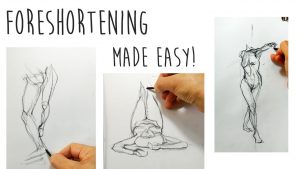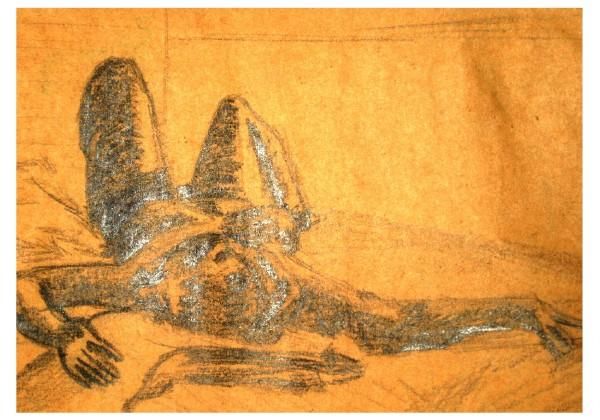The important guide to foreshortening in the artwork.All you want to understand about foreshortening, and a way to do it realistically.Foreshortening in artwork: drawing of a woman reclining.
If you are wondering what foreshortening in the artwork is, we are sure you are not alone. Hopefully, by the cease of this post, you may understand precisely what it is and a way to create believably foreshortened images. It’s a method that is extraordinarily hard to master. In fact, artists have struggled with foreshortening since its first mentioned use by Florentine artist Fillipo Brunelleschi again in 1415, so if you are having problems getting to grips with it, you are in the right company.
Thankfully, there are some easy steps to observe to help you become familiar with the fundamental principles of foreshortening. We’ll share those with you, plus we will display you some drawing strategies to help you ‘sculpt’ your difficulty’s dimensions using a pencil or brush.
What is foreshortening in artwork?

If you’re having problems portraying depth for your drawings and artwork then possibilities are you’re struggling with something referred to as foreshortening. Foreshortening is all about realistically conveying 3 dimensions in a 2D medium through displaying items shifting away from the viewer. Being capable of correctly drawing objects receding in the area will make your drawings and artwork extra practical and assist pull your viewer into the scene you need to set.
Foreshortening in artwork: Figure drawing
Figure drawing is a common region to encounter foreshortening troubles We’re going to examine foreshortening in the surroundings most people first encounter it: the existence drawing class. We’ll recognize a figure reclining in sturdy foreshortening to clearly push this theory however, the equal strategies may be used something your subject might be.
1.Plan your area
First, you want to set out your subject’s barriers on your preferred support (i.e. your paper or canvas). It’s all too smooth to begin drawing afoot at the lowest of the page, most effective to find out later that the top truly ends about six inches above the top of the page. The tendency is for the artist to attempt to correct this by squishing the figure into the page, which absolutely throws out any realism for your picture. If, in addition to that, you’re aware you’ve finished this, then it is a great deal better to begin once more.
2.Add guidelines
Try and match your figure right into a rectangle/square and draw it at the paper gently so it’s smooth to amend or delete later. Use measuring strategies to ensure that is as correct as possible. Next, you’ll need to attract in a plumb line. This is a vertical line, a good way to act as a marker to measure against throughout the construction of your composition. It oughtn’t always to be the centre line of your composition (all becomes clean quickly).
3.Forget the whole thing you observed you know
Forget all of your preconceived intellectual images of how you observed the human shape. Observe and draw what you see, not what you observed you need to see. This sounds easy, however, it’s the primary stumbling block for each artist that tries foreshortening. Measure, degree and measure once more, and accept as true with your measurements. In sturdy foreshortening, the human shape does not match our preconceived ideas
4. Block in the massive forms
Start off by drawing in the huge form shapes and forget about any sort of detail. Using your plumb line to measure off, you could see how the primary anatomical structures engage with every other. Measuring absolutes may be useful – halfway, quarter waypoints and so on. Mark midway up your vertical line from the bottom of your shape to the top and spot wherein this falls in your issue – it won’t be wherein you believe it is. Keep things mild and easy so they’re smooth to amend, and preserve measuring.
5.Pull the whole thing collectively:
Once you’ve been given the primary massive areas of anatomy in the area it is time to begin pulling everything collectively. It’s vitally essential to attempt to think about your difficulty in terms of its sculptural 3 dimensions at this factor. You need to see, and importantly draw, how the anatomy stacks collectively, flesh in the front of flesh. Feet in the front of calves, calves in the front of thighs, thighs in the front of buttocks etc.
Let your pencil or paintbrush travel on an adventure throughout the landscape of the flesh, following its undulating plains and describing them together along with your marks. Foreshortening strategies to attempt In the subsequent steps we will define multiple strategies that will help you carry flesh to the bones of your creation drawings. Experiment and spot what works satisfactory for you. As lengthy as you have a sturdy basis to construct upon you shouldn’t move some distance wrong. If you do locate things are searching wrong, move again in your most important huge shapes and ensure they’re 100 per cent correct. Whichever approach you move for, excellent working information of human anatomy may be useful.
6.The geometry approach Foreshortening in artwork:
Break the shape into easy geometric shapes Breaking the human shape down into easy geometric shapes may be clearly useful while you’re looking to get your head around anatomy, specifically with a foreshortened angle. Imagine the limbs are tapering cylinders and the torso is a choice of cuboids. Also, attempt to believe how those geometric shapes match collectively and match accordingly. Once you have these easy shapes in the area and the proportions are operating, it could be an easy matter of knocking off the edges to show the human shape underneath.
7.The coil (or spiral) approach Foreshortening in artwork:
coil approach The lines of the spiral have to observe your figure’s contours The coil (or spiral), the approach is all about constructing 3 dimensions by drawing shape through the utility of concentric eclipses, or spirals, that observe the contours of your issue. It’s certainly satisfactory to apply a pencil pretty gently while making use of this approach as it can become rather messy and you’ll want to do an honest little bit of rubbing out. When describing a shape that is vertical or horizontal, the coils will seem nearly flat or as easy strains. As quickly because the shape acts away from you or in the direction of then you the coils open up, morphing from strains into eclipses and on into close to circles earlier than flattening off once more when the shape modifies direction. It’s an excellent approach for feeling out your shape.
Also Read:
Food You Shouldn’t Miss In The Orange City Of India
INDIAN SPICES AIDING TO STIMULATE IMMUNE SYSTEM
INDIAN FRUITS YOU SHOULD NEVER MISS
Top 10 Beverages You Should Give A Try
Sweets You Should Not Miss In Ganesh Chaturthi
5 Special Sweets On The Occasion Of Ganesh Chaturthi
